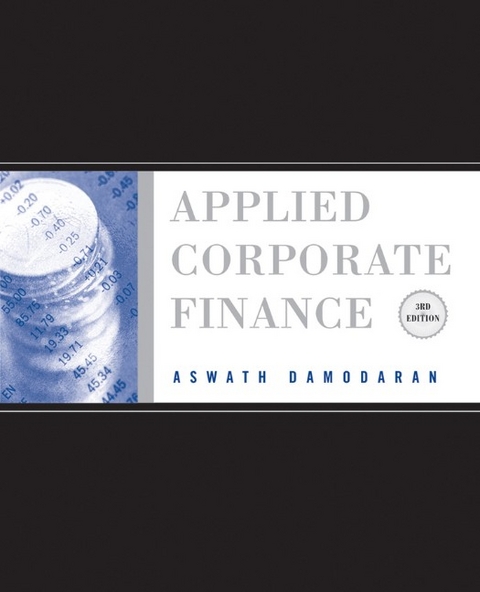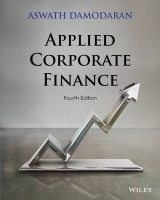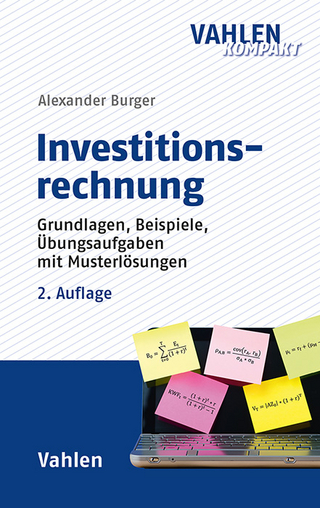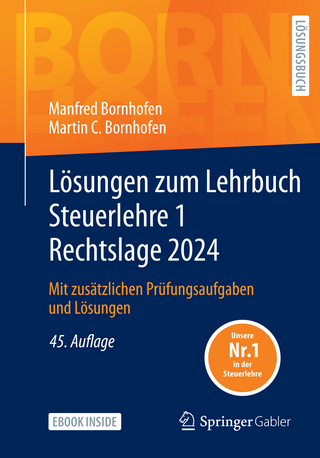
Applied Corporate Finance
John Wiley & Sons Ltd (Verlag)
978-0-470-38464-0 (ISBN)
- Titel erscheint in neuer Auflage
- Artikel merken
Readable and usable in style and valuable in approach, this text provides the practical and succinct advice that students and practitioners need, rather than a sole concentration on debate theory, assumptions, or models. Like no other text of its kind, the author applies corporate finance to real companies. The new Third Edition has four real-world core companies to study and follow. Perfected suited for MBA programs corporate finance and equity valuation courses, all business decisions are classified into three groups: the investment, financing, and dividend decisions.
P REFACE. ACKNOWLEDGMENTS. CHAPTER 1 THE FOUNDATIONS. The Firm: Structural Set-up. First Principles. Corporate Financial Decisions, Firm Value, and Equity Value. A Real-World Focus. A Resource Guide. Some Fundamental Propositions about Corporate Finance. Conclusion. CHAPTER 2 THE OBJECTIVE IN DECISION MAKING. Choosing the Right Objective. The Classical Objective. Maximize Stock Prices: The Best-Case Scenario. Maximize Stock Prices: Real-World Conflicts of Interest. Alternatives to Stock Price Maximization. Maximize Stock Prices: Salvaging a Flawed Objective. A Postscript: The Limits of Corporate Finance. Conclusion. LIVE CASE STUDY: Corporate Governance Analysis. Problems and Questions. CHAPTER 3 THE BASICS OF RISK. Motivation and Perspective in Analyzing Risk. Equity Risk and Expected Returns. The Risk in Borrowing: Default Risk and the Cost of Debt. Conclusion. LIVE CASE STUDY: Stockholder Analysis. Problems and Questions. CHAPTER 4 RISK MEASUREMENT AND HURDLE RATES INPRACTICE. Cost of Equity. From Cost of Equity to Cost of Capital. Conclusion. LIVE CASE STUDY: Risk and Return: Analysis for theFirm. Problems and Questions. CHAPTER 5 MEASURING RETURN ON INVESTMENTS. What Is a Project? Hurdle Rates for Firms versus Hurdle Rates for Projects. Measuring Returns: The Choices. Investment Decision Rules. Probabilistic Approaches to Investment Analysis. Conclusion. LIVE CASE STUDY: Estimating Earnings and Cash Flows. Problems and Questions. CHAPTER 6 PROJECT INTERACTIONS, SIDE COSTS, AND SIDEBENEFITS. Mutually Exclusive Projects. Side Costs from Projects. Side Benefits from Projects. Options Embedded in Projects. Measuring the Quality of Existing Investments. Conclusion. LIVE CASE STUDY: Estimating Earnings and Cash Flows. Problems and Questions. CHAPTER 7 CAPITAL STRUCTURE: OVERVIEW OF THE FINANCINGDECISION. The Choices: Types of Financing. Financing Behavior. The Process of Raising Capital. The Tradeoff of Debt. No Optimal Capital Structure. There Is an Optimal Capital Structure. How Firms Choose Their Capital Structures. Conclusion. LIVE CASE STUDY: Analyzing a Firm s CurrentFinancing Choices. Problems and Questions. CHAPTER 8 CAPITAL STRUCTURE: THE OPTIMAL FINANCIALMIX. Operating Income Approach. Cost of Capital Approach. Adjusted Present Value Approach. Comparative Analysis. Selecting the Optimal Debt Ratio. Conclusion. LIVE CASE STUDY: The Optimal Financing Mix. Problems and Questions. CHAPTER 9 CAPITAL STRUCTURE: THE FINANCING DETAILS. A Framework for Capital Structure Changes. Immediate, Gradual or no Change. Choosing the Right Financing Instruments. Conclusion. LIVE CASE STUDY: Mechanics of Moving to the Optimal. Problems and Questions. CHAPTER 10 DIVIDEND POLICY. Background on Dividend Policy. When Are Dividends Irrelevant? The Dividends Are Bad School. The Dividends Are Good School. Managerial Interests and Dividend Policy. Conclusion. LIVE CASE STUDY: The Tradeoff on Dividend Policy. Problems and Questions. CHAPTER 11 ANALYZING CASH RETURNED TO STOCKHOLDERS. Cash Returned to Stockholders. A Cash Flow Approach to Analyzing Dividend Policy. A Comparable Firm Approach to Analyzing Dividend Policy. Managing Changes in Dividend Policy. Conclusion. LIVE CASE STUDY: A Framework for Analyzing Dividends. Problems and Questions. CHAPTER 12 VALUATION: PRINCIPLES AND PRACTICE. Discounted Cash Flow Valuation. Relative Valuation. Reconciling Different Valuations. Conclusion. LIVE CASE STUDY: Valuation. Problems and Questions. Appendix 1 Basic Statistics. Appendix 2 Financial Statements. Appendix 3 Time Value of Money. Appendix 4 Option Pricing. GLOSSARY. INDEX.
| Zusatzinfo | Illustrations |
|---|---|
| Verlagsort | Chichester |
| Sprache | englisch |
| Maße | 190 x 234 mm |
| Gewicht | 1058 g |
| Themenwelt | Wirtschaft ► Betriebswirtschaft / Management ► Finanzierung |
| ISBN-10 | 0-470-38464-6 / 0470384646 |
| ISBN-13 | 978-0-470-38464-0 / 9780470384640 |
| Zustand | Neuware |
| Haben Sie eine Frage zum Produkt? |
aus dem Bereich



